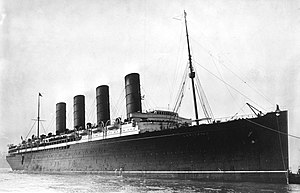 Lusitania arriving in New York City in 1907
| |
| History | |
|---|---|
| Name | Lusitania |
| Namesake | Lusitania |
| Owner | |
| Port of registry | Liverpool |
| Route | Liverpool – Queenstown – New York |
| Builder | John Brown & Co, Clydebank |
| Yard number | 367 |
| Laid down | 17 August 1904 |
| Launched | 7 June 1906[1] |
| Christened | Mary, Lady Inverclyde |
| Acquired | 26 August 1907 |
| Maiden voyage | 7 September 1907 |
| In service | 1907 – 1915 |
| Out of service | 7 May 1915 |
| Identification |
|
| Fate | Torpedoed and sunk by the SM U-20, on 7 May 1915 |
| General characteristics | |
| Type | Ocean liner |
| Tonnage | 31,550 GRT, 12,611 NRT |
| Displacement | 44,060 long tons (44,767.0 t) |
| Length | |
| Beam | 87.8 ft (26.8 m) |
| Height | 65 ft (19.8 m) to boat deck, 165 ft (50.3 m) to aerials, 104 ft (31.7 m) from keel to top of boat deck, 144 ft (43.9 m) from keel to top of funnels |
| Draught | 33.6 ft (10.2 m) |
| Depth | 56.6 ft (17.3 m) |
| Decks | 6 passenger decks, 10 overall[2] |
| Installed power | 25 fire-tube boilers; four direct-acting Parsons steam turbines producing 76,000 hp (57 MW) |
| Propulsion |
|
| Capacity | 552 first class, 460 second class, 1,186 third class; 2,198 total. |
| Crew | 850 |
| Notes | First British four-funnelled ocean liner |
RMS Lusitania (named after the Roman province corresponding to modern Portugal and portions of western Spain) was a British ocean liner launched by the Cunard Line in 1906. She was the world's largest passenger ship until the completion of her sister Mauretania three months later and was awarded the Blue Riband appellation for the fastest Atlantic crossing in 1908. Lusitania was sunk on her 202nd trans-Atlantic crossing, on 7 May 1915 by the German submarine U-20, 11 miles (18 km) off the Old Head of Kinsale, Ireland, killing 1,197 passengers, crew and stowaways.[3] The sinking occurred about two years before the United States declaration of war on Germany, but significantly increased American domestic public support for entering the war.
- ^ a b Atlantic Liners.
- ^ "Deck plans". The Lusitania Resource. 24 March 2011.
- ^ The official figures give 1,195 lost out of 1,959, excluding three stowaways who also were lost. The figures here eliminate some repetitions from the list and people subsequently known not to be on board. "Passenger and Crew Statistics". The Lusitania Resource. 12 December 2010. Retrieved 27 April 2024.
Cite error: There are <ref group=lower-alpha> tags or {{efn}} templates on this page, but the references will not show without a {{reflist|group=lower-alpha}} template or {{notelist}} template (see the help page).